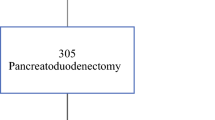Abstract
Background
Pancreatic fistula (PF) is considered to be the main cause of morbidity after pancreaticoduodenectomy (PD). A recent study from our institution suggested the risk for pancreatic fistula after distal pancreatectomy to be closely related to the pancreatic remnant volume (PRV). The hypothesis was formulated that after PD the PRV is an important determinant of the risk for PF formation.
Method
All patients undergoing PD between September 2007 and November 2010 at the Karolinska University Hospital Stockholm were included. Preoperative multidetector computed tomography (CT) or magnetic resonance imaging (MRI) was used to calculate the PRV and the pancreatic duct width (PDW) at the alleged resection line.
Results
A total of 182 patients (median age 67 years) undergoing PD were included. The diagnosis was malignant in 144 patients (79.1 %) and benign in 38 (20.9 %). Pancreatic fistula defined according to the International Study Group on Pancreatic Fistula (ISGPF) criteria was diagnosed in 37 patients (20.3 %). The median PRV was 35.2 cm3 and the median PDW was 3.9 mm. In a univariate analysis a large calculated volume of the pancreatic remnant increased the subsequent risk of PF (odds ratio [OR], 3.71; 95% confidence interval [95% CI], 1.58–8.71; P < 0.01), as did a small duct width (OR, 8.46; 95% CI, 3.11–23.04; P < 0.01). According to the multivariate analysis, the size of the pancreatic remnant and the width of the pancreatic duct maintained their impact on leakage risk.
Conclusions
A large pancreatic volume and small pancreatic duct increase the risk of PF. Preoperative CT and/or MRI therefore are useful in predicting fistula formation before pancreaticoduodenectomy.



Similar content being viewed by others
References
Yeo CJ, Cameron JL, Sohn TA et al (1997) Six hundred fifty consecutive pancreaticoduodenectomies in the 1990s: pathology, complications, and outcomes. Ann Surg 226:248–257 discussion 257–260
Cullen JJ, Sarr MG, Ilstrup DM (1994) Pancreatic anastomotic leak after pancreaticoduodenectomy: incidence, significance, and management. Am J Surg 168:295–298
Muscari F, Suc B, Kirzin S et al (2006) Risk factors for mortality and intra-abdominal complications after pancreatoduodenectomy: multivariate analysis in 300 patients. Surgery 139:591–598
Butturini G, Marcucci S, Molinari E et al (2006) Complications after pancreaticoduodenectomy: the problem of current definitions. J Hepatobiliary Pancreat Surg 13:207–211
Mathur A, Pitt HA, Marine M et al (2007) Fatty pancreas: a factor in postoperative pancreatic fistula. Ann Surg 246:1058–1064
Yang YM, Tian XD, Zhuang Y et al (2005) Risk factors of pancreatic leakage after pancreaticoduodenectomy. World J Gastroenterol 11:2456–2461
Dinter DJ, Aramin N, Weiss C et al (2009) Prediction of anastomotic leakage after pancreatic head resections by dynamic magnetic resonance imaging (dMRI). J Gastrointest Surg 13:735–744
Tajima Y, Kuroki T, Tsutsumi R et al (2008) Risk factors for pancreatic anastomotic leakage: the significance of preoperative dynamic magnetic resonance imaging of the pancreas as a predictor of leakage. J Am Coll Surg 202:723–731
Noun R, Riachy E, Ghorra C et al (2008) The impact of obesity on surgical outcome after pancreaticoduodenectomy. Jop (J Pancreas online) 9:468–476
Hosotani R, Doi R, Imamura M (2002) Duct-to-mucosa pancreaticojejunostomy reduces the risk of pancreatic leakage after pancreatoduodenectomy. World J Surg 26:99–104. doi:10.1007/s00268-001-0188-z
Frozanpor F, Albiin N, Linder S et al (2010) Impact of pancreatic gland volume on fistula formation after pancreatic tail resection. Jop (J Pancreas online) 11:439–443
Evans DB, Farnell MB, Lillemoe KD et al (2009) Surgical treatment of resectable and borderline resectable pancreas cancer: expert consensus statement. Ann Surg Oncol 16:1736–1744
Bassi C, Dervenis C, Butturini G et al (2005) Postoperative pancreatic fistula: an international study group (ISGPF) definition. Surgery 138:8–13
Wente MN, Bassi C, Dervenis C et al (2007) Delayed gastric emptying (DGE) after pancreatic surgery: a suggested definition by the International Study Group of Pancreatic Surgery (ISGPS). Surgery 142:761–768
Dindo D, Demartines N, Clavien PA (2004) Classification of surgical complications: a new proposal with evaluation in a cohort of 6336 patients and results of a survey. Ann Surg 240:205–213
Reid-Lombardo KM, Farnell MB, Crippa S et al (2007) Pancreatic anastomotic leakage after pancreaticoduodenectomy in 1,507 patients: a report from the Pancreatic Anastomotic Leak Study Group. J Gastrointest Surg 11:1451–1458 discussion 1459
Crippa S, Salvia R, Falconi M et al (2007) Anastomotic leakage in pancreatic surgery. HPB (Oxford) 9:8–15
Adams DB (2009) The pancreatic anastomosis: the danger of a leak, which anastomotic technique is better? J Gastrointest Surg 13:1182–1183
Lai EC, Lau SH, Lau WY (2009) Measures to prevent pancreatic fistula after pancreatoduodenectomy: a comprehensive review. Arch Surg 144:1074–1080
Sarr MG (2003) The potent somatostatin analogue vapreotide does not decrease pancreas-specific complications after elective pancreatectomy: a prospective, multicenter, double-blinded, randomized, placebo-controlled trial. J Am Coll Surg 196:556–564 discussion 564–555; author reply 565
Sakata N, Egawa S, Rikiyama T et al (2010) Computed tomography reflected endocrine function of the pancreas. J Gastrointest Surg 15:525–532
Reiner CS, Karlo C, Petrowsky H et al (2009) Preoperative liver volumetry: how does the slice thickness influence the multidetector computed tomography—and magnetic resonance-liver volume measurements? J Comput Assist Tomogr 33:390–397
Dixon E, Fingerhut A, Bassi C (2006) Meta-analysis of pancreaticojejunostomy versus pancreaticogastrostomy reconstruction after pancreaticoduodenectomy Br J Surg 93(8):929–936
Author information
Authors and Affiliations
Corresponding author
Additional information
F. Frozanpor and L. Loizou contributed equally to this study.
Rights and permissions
About this article
Cite this article
Frozanpor, F., Loizou, L., Ansorge, C. et al. Preoperative Pancreas CT/MRI Characteristics Predict Fistula Rate after Pancreaticoduodenectomy. World J Surg 36, 1858–1865 (2012). https://doi.org/10.1007/s00268-012-1567-3
Published:
Issue Date:
DOI: https://doi.org/10.1007/s00268-012-1567-3




